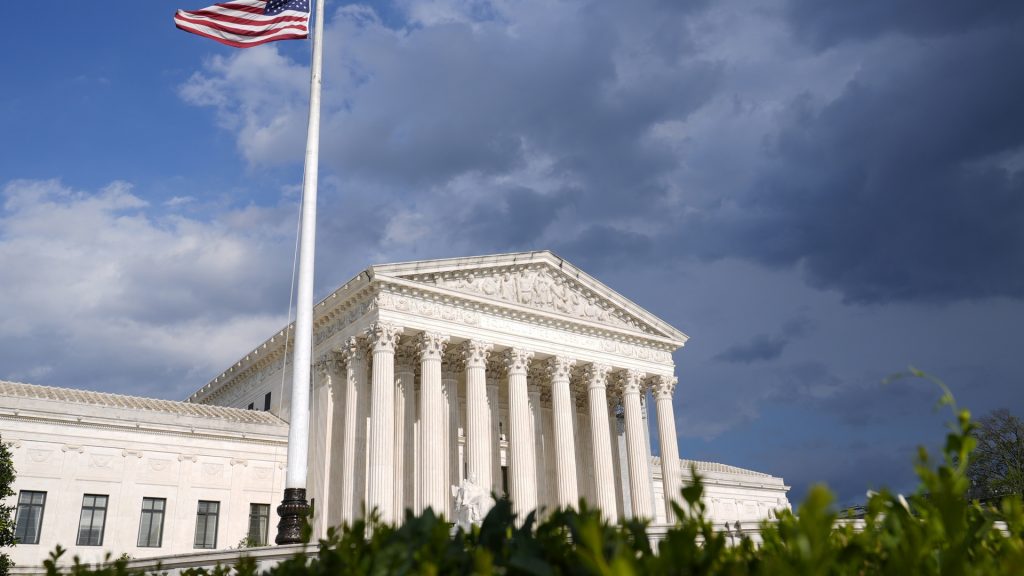How the Supreme Court’s 2025-26 term could shape the political landscape

The Supreme Court is set to begin its next term on Monday, with a series of high-profile cases that could dominate political narratives for years to come. Some of the cases on the docket over the next nine months concern presidential powers, redistricting efforts and trans rights.
A Conservative majority has been locked into the bench since President Donald Trump’s first term. While Trump-appointed justices haven’t exclusively sided with his administration in every case, their next term could prove integral to the president’s agenda.
Irv Gornstein, executive director of the Supreme Court Institute at Georgetown University’s law school, told The Associated Press that the next nine months could shape up to be “one of the most polarizing terms yet.”
And according to Morgan Marietta, a professor of American civics at the University of Tennessee, this term’s docket hinges on three “dominant themes” –– a reading of the Constitution as an evolving, living document as opposed to a strict traditionalist interpretation, the deep cultural divides in America, and partisan advantages in governing.
The legality of Trump’s tariffs
One of the first cases to be heard in the coming term concerns Trump’s sweeping tariffs, which were first imposed in April and have become a linchpin of the president’s economic priorities. The court agreed to hear the case in September.
A federal appeals court had ruled Trump overstepped his authority by imposing tariffs. However, the president’s team quickly appealed to the high court. The justices asked the government and a group of small businesses to expedite briefings in the case, and it is set to hear arguments during the first week of November.
Generally speaking, Congress reserves the right to levy tariffs and control other aspects of the federal government’s economic powers. As such, the court will rule in Learning Resources v. Trump, which questions whether a 1977 act paves the way for the president’s imposition of tariffs.
“The answer hinges on the application of what’s known as the ‘major questions doctrine,’” Marietta wrote in The Conversation, “which limits presidential authority over issues of great economic or policy importance in the absence of direct endorsement from Congress.”
Conversion therapy and trans rights
In the realm of America’s growing cultural divide, the Supreme Court is set to hear several cases on gender identity and trans rights.
One such case challenges a Colorado ban on conversion therapy, stemming from an appeal by a Christian therapist, who argued the ban violates her First Amendment rights. More than 20 states have similar bans targeting the LGBTQ+ community, so whatever the Supreme Court decides is likely to impact a greater area than just the state of Colorado.
The lawsuit argues that the ban on such counseling violates a licensed therapists’ constitutional rights by limiting what they are allowed to talk about during confidential conversations. However, lawyers for Colorado said the decision was “based on overwhelming evidence that efforts to change a child’s sexual orientation or gender identity are unsafe and ineffective.”
“Generally, you can’t require a license in order to talk and you can’t regulate what people are talking about,” said Rob Johnson, a senior attorney with The Institute for Justice. “So, the question arises, does speech get less protection just because it is speech by somebody who is licensed? Does the government get extra leeway to regulate speech when it’s pursuant to a licensing law?”
The Supreme Court also agreed to hear challenges to laws in West Virginia and Idaho that ban transgender athletes from competing in women’s sports, marking the first time the justices will rule on the controversial matter that has been the subject of nationwide debate and dozens of lawsuits.
At play in that case is Title IX and the 14th Amendment, which guarantee equal protection regardless of race and gender.
As Marietta notes, Constitutional originalists agree that the clauses protect against race- and gender-based discrimination, but that the U.S.’ foundational document does not include space for trans individuals or gender identities. At the same time, the Constitution does provide ample room for states to make their own determinations in this regard.
“For these reasons the court majority is likely to see the regulation of who gets to participate in women’s sports as a state-by-state decision,” Marietta writes.
Birthright citizenship
Also crucial to an interpretation of the 14th Amendment is birthright citizenship, a right that’s been enshrined in the Constitution since 1868, but which Trump attempted to curtail with an executive order early in his second term.
In March, the administration asked the high court to lift a nationwide pause on its executive order. Birthright citizenship grants American citizenship to children of unauthorized immigrants and foreign residents who are born on U.S. soil.
If upheld, the policy would strip birthright citizenship from thousands of children born in the U.S. to non-citizen, non-resident parents. The decision could create legal uncertainty, leading to challenges over immigration status, deportation proceedings and retroactive citizenship claims.
Aside from the citizenship question itself, the administration’s request to the Supreme Court also challenged its authority in imposing nationwide injunctions –– or a ruling that’s imposed across the country and is not limited to the jurisdiction in which the case was brought.
As such, the Supreme Court’s decision could reshape how lower courts handle nationwide injunctions. If the justices rule in favor of limiting injunctions, it could make it harder for courts to block presidential policies nationwide, affecting future challenges on immigration, healthcare and other federal actions.
Additional cases before the court
A litany of other decisions will come before the court between Oct. 6 and June 25, including cases involving the firing of federal appointees, Louisiana redistricting, an inmate’s religious rights, an abortion and pregnancy center case, limits on campaign finance and more.
The post How the Supreme Court’s 2025-26 term could shape the political landscape appeared first on Straight Arrow News.





